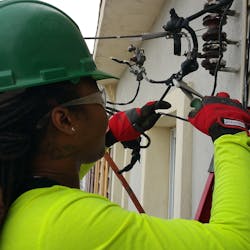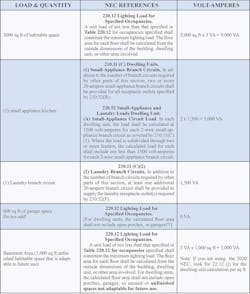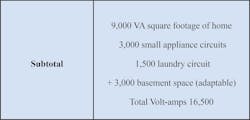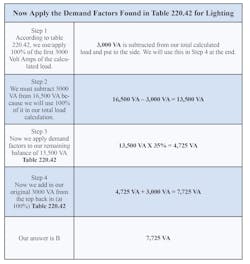It’s good to have goals. At the beginning of your career, most of your concerns are fundamental, such as learning which tools to use, memorizing the names of materials, and showing up on time every day. However, as you grow steadily into a confident journeyman or journeywoman, your skillsets will need to vastly exceed your current capabilities to succeed in the broad electrical industry. To reach the next level of your career, you will need to master many skills, including:
- How to convert electrical loads into feeders and branch circuits.
- Becoming confident, comfortable, and efficient with basic math.
- Having a firm grasp on navigating Chapter 2 (Wiring and Protection).
When it comes to performing calculations on the job, it may seem as if the boss is working some kind of magic, but that’s not the case. He or she is simply using basic math and simple formulas found in Annex D at the rear of your Code book. Standard and optional formulas are used to convert electrical loads into "properly" sized branch circuits and feeders. Always remember that Chapter 2 is used during the planning stage of a project. The various tables organized in Art. 220 (Branch-Circuit, Feeder, and Service Load Calculations) are used during the project's design process before any screws are turned. In addition, never forget that the National Electrical Code (NEC) only sets the minimum standards for installation — so be prepared to do more if the local jurisdiction you’re working in requires you to do so.
To help you put this concept into practice, let’s take a look at a hypothetical scenario. The following example demonstrates a formula used to calculate service entrance conductors for a dwelling unit typically used in a licensing examination or journeyman test:
Ellie has a dwelling unit with 3,000 sq ft of habitable space with laundry facilities and bathrooms, 600 sq ft of the garage, and 1,000 sq ft of unfinished habitable space that is adaptable to future use. When calculating the service-conductor size for this dwelling unit using the standard calculation method, the minimum demand is ___________ volt-amperes.
A. 6,150
B. 7,725
C. 12,000
D. 16,500
Step 1. Organize your loads for the calculation.
The instructions are listed in 220.12 and Table 220.42.
Step 2. Apply demand factors found in Table 220.42 for lighting loads.
Only a tiny portion of the calculated load in Ellie's house will be used at any given time during the day or evening. However, there’s a slim chance she'll need 100% of the available power from every lighting outlet, receptacle, or appliance. That means we apply demand factors. If we did not apply demand factors, our electrical services would be grossly oversized; we would waste labor, time, and materials. Therefore, demand factors are a "discount" applied to electrical usage on the main service calculation.
Note: 220.14(J) explains that our calculated load includes general-purpose receptacles and non-dedicated receptacles located throughout the dwelling unit [e.g., bedrooms, hallway, dining room, outdoors, etc.] so no additional load calculation is required for these devices.
Don't get creative when performing this calculation; focus on the loads in the question as well as the basic formula. Follow Annex D (1) (A) instructions if you get confused. This is the standard method; only use the optional method if instructed.
Follow my column for more practical how-to articles and tips for applying electric basics concepts in the field (Everyday Instructions for Electricians, Introduction to Commercial Service Calculations, Introduction to Residential Service Calculations, The Apprentice’s Guide to Non-Metallic Sheathed Cable, The Apprentice’s Guide to NEC Chapter 4, and The Apprentice’s Guide to Art. 300). For more information on why a structured approach is so important to navigating the NEC and how to put its requirements into practice in real-world settings, read “The NEC for Newbies.”
Harold De Loach, a master electrician and electrical trainer/instructor, is the founder of The Academy of Industrial Arts (www.taia-school.com) in Philadelphia. With more than 30 years of experience in the field, he writes regular exclusive content for the E-Train and can be reached at [email protected].
About the Author
Harold De Loach
De Loach is the Director of Education and Training for the Leaders of Electrical License Preparation courses for Philadelphia and The Lehigh Valley (www.necprepclass.com). He is the founder and Director of The Academy of Industrial Arts L.L.C. (www.taia-school.com), a customized electrician training program that provides entry-level electrician training courses, electrical safety classes and customized electrical construction courses. He is trained by the National Center for Construction Education and Research (NCCER). He is a member of The National Society of Collegiate Scholars, the Independent Association of Electrical Inspectors, the Electrical Association of Philadelphia, and the Better Business Bureau.
His level of knowledge affords him to teach entry, intermediate, and master level electricians. Armed with more than 20 years of experience in the electrical, general construction, and real estate development industry, he offers his students and clients several unique skill sets. He has worked as the Head Craft Instructor and Assistant Director of Education at the Apprenticeship Training Center (affectionately known as The ABC School) in Harleysville Pennsylvania for Associated Builders and Contractors (The South-Eastern Pa. Chapter). Prior to Joining ABC, he directed a work-readiness (Re-Entry) Construction Technology program within The Philadelphia Prison System and as an Electrical Technician Program instructor at Kaplan Career Institute (Formerly Thompson institute) in Center City Philadelphia and Franklin Mills. He is available for consultation, private tutoring, speaking engagements, or strategic partnerships that can bolster the number of new electricians entering the industry.




